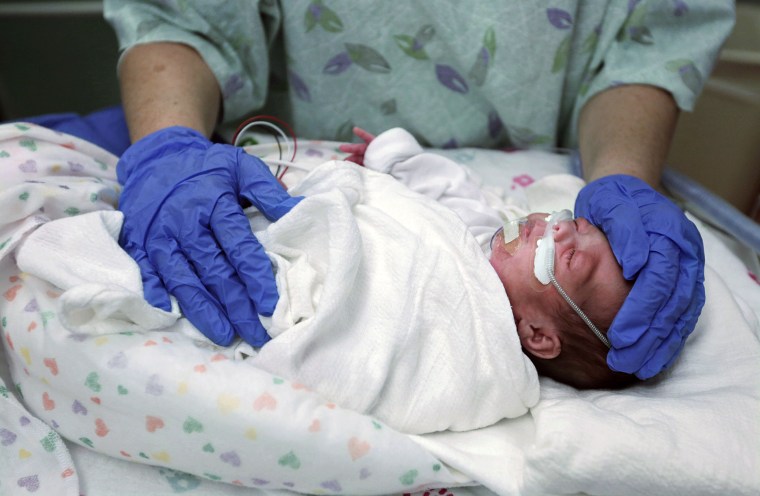Nearly 10 percent of babies born in the U.S. are born prematurely and the rates of preterm birth are going up, a new government report shows.
Also more low birth weight babies were born last year than in previous years, the Centers for Disease Control and Prevention reported Friday.
With half of all U.S. births covered by Medicaid, these rates would get even worse if Congress cuts back on the program, advocates said. Medicaid covers 75 million people, including nearly 36 million children, according to data released last week by the Centers for Medicare and Medicaid Service.

Already the United States has much worse rates of infant mortality, preterm birth and low birth weight babies than other industrialized countries. The new data from the CDC’s National Center for Health Statistics (NCHS) shows no improvement.
“The increase in the preterm birth rate is an alarming indication that the health of pregnant women and babies in our country is heading in the wrong direction,” said Stacey Stewart, president of the March of Dimes, a charity focused on ending birth defects.
“Preterm birth is the number one cause of death among babies and a leading cause of lifelong disabilities,” she added.
While births overall fell across the U.S., high-risk births became more common, the NCHS found.
“The preterm birth rate rose for the second year in a row, to 9.84 percent in 2016. The low birth weight rate was also up for the second straight year to 8.16 percent,” the NCHS team wrote in their report.
Related: Medicaid Births Rose When Texas Defunded Planned Parenthood
“After falling 8 percent from 2007 to 2014, the preterm rate has increased for the second year in a row.” The U.S. define preterm births as those that happen before 37 weeks of gestation.
The report just looks at numbers and does not go into reasons for the preterm and low-weight births. But a lack of prenatal care, obesity, tobacco use and some fertility treatments can all lead to early births. Teenagers and women who have babies spaced too closely together also have higher rates of preterm birth.
The NCHS team found that women of Asian ethnic origin had the lowest rates of preterm births, at 8.6 percent, while African-American women had the highest rates, at 13.75 percent of all births.
States with the most preterm births: Alabama, Arkansas, Florida, Georgia, Hawaii, Illinois, Kentucky, Louisiana, Maryland, Mississippi, Missouri, North Carolina, Ohio, Oklahoma, South Carolina, Tennessee, Texas and West Virginia. Washington, D.C., was also included.
States where 10 percent or more of women got late prenatal care or no prenatal care: Arkansas, New Mexico, and Texas. In Vermont, just 1.6 percent of women got late prenatal care or no prenatal care.
Only New Hampshire, Oregon and Vermont had preterm rates below 8 percent.
Related: Too Many Babies Die on Their First Day
“It is unacceptable that black women have a preterm birth rate about 50 percent higher than the rate among white women. The chance of a baby’s survival should not depend on where a baby is born, or the income, race, and ethnicity of her mom,” said Stewart.
The March of Dimes said that the health care bill currently working its way through Congress could make matters worse.
“As the Senate considers the Better Care Reconciliation Act (BCRA), we estimate that up to 6.5 million women of childbearing age could lose health insurance. Combined with proposed rules changes, this would mean fewer pregnant women would receive prenatal care, and fewer premature babies would receive the specialized treatment they need to survive and thrive,” the organization said in a statement.
According to Save the Children, the United States has the highest rate of babies who die the day they are born in the industrialized world. It says 130 countries have lower preterm birth rates than the U.S.
Other findings from the NCHS report:
- Births were down 1 percent from 2015. The CDC found that 3,941,109 babies were born in 2016.
- The low birth weight rate rose for the second straight year in 2016, to 8.16 percent, from 8.07 percent in 2015. Low birth weight is defined as less than 2,500 grams, or 5 lb., 8 oz. Low weight births have increased by 2 percent since 2014.
- Just under 7 percent of white babies weighed too little at birth, compared to 13.7 percent of African-American babies.
- The birth rate for teenagers aged 15–19 declined 9 percent in 2016 to 20.3 births per 1,000 women.
- The birth rate fell to 73.7 births per 1,000 women aged 20–24 and to a rate of 101.9 births for women aged 25–29. The rates also fell for women in their 30s and 40s.
- Just 77 percent of women began prenatal care in the first trimester — when they should — and 6.2 percent did not get care until the third trimester or after they gave birth.
- The cesarean delivery rate declined for the fourth year in a row to 31.9 percent and the low-risk cesarean delivery rate fell to 25.7 or births in 2016.
